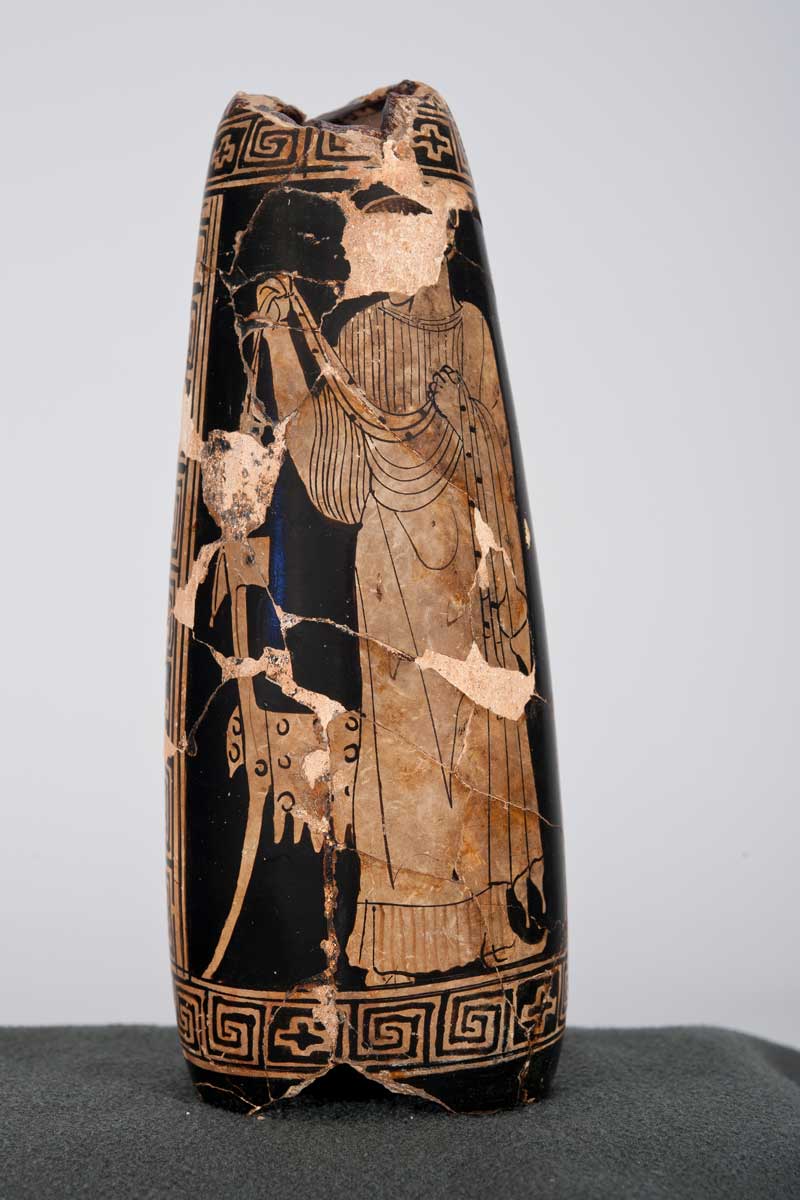Archaeology of Daily Life | Female Beauty
Red-Figure Alabastron
By Hérica Valladares


Material: Ceramic
Date: 450-430 B.C.
Origin: Athenian
Find Spot: Unknown
Collection: Kimpson
Accession Number: K101
Although the painted decoration of the red-figure alabaston is slightly chipped and cracked, it is still relatively well preserved. Bands of meander and cross-circle design trace the rim of the neck and the base, and also run vertically to separate the painted panels into two scenes. Side A illustrates a seated woman in profile. She wears a tunic (chiton in Greek) with a himation (i.e. a cloak) over it. Her hair is pulled back and bound with a fillet. She is also shown wearing hoop earrings. This woman holds a mirror with her left hand, which she uses to admire herself. At her feet, we see a basket of wool. Side B depicts a woman standing frontally with her head turned to the right. Her face, however, is much damaged. Like the seated woman on side A, the woman on side B also wears a chiton and a himation. She is portrayed holding a piece of drapery or a fillet with both hands. To her right, one sees a klismos or chair.
Prior to the fifth century, vase paintings that featured women tended to show them alongside adult men. However, during the fifth century, we observe a significant spike in the number of vases decorated with scenes showing women on their own. The exact cause of this change is unknown. Typically, these representations of women on Classical Greek vases show them engaged in feminine activities related to the domestic sphere. Popular motifs include scenes of women spinning or working with wool, bathing, dressing or mirror-gazing —much like the ones on the red-figure alabastron in the JHUAM.
The majority of Classical Greek vases that feature images of women in the domestic sphere were intended for female personal use. This was, in fact, the case with the JHUAM alabastron. Alabastra are typically seven to twenty centimeters tall. Their small, elongated, narrow-necked form made them perfect containers for perfume and scented oils. Although they do not have handles, alabastra often featured either string holes or lugs, which allowed them to be hung. This type of vessel was, then, both practical and well-suited for women’s use. In the JHUAM alabastron, we see how a vessel’s form, function and décor can be elegantly inter-related.
Despite the artists’ depiction of real-life details, Classical Greek portrayals of women are not straightforward shap-shots of everday existence in the fifth century B.C.E. These images represent, instead, an ideal and help us understand the roles women were expected to play in the ancient world. For example, on Side A of the red-figure alabastron in the JHUAM, we see depictions of two symbolically-charged everyday activities: mirror-gazing and wool-work. Mirror gazing alludes to the world of female adornment, which functioned both as a status marker and as an indication of women’s refinement. The basket of wool also evokes a concrete, everyday activity regularly performed by women in Classical Greek households. Wool-work, however, was also seen as a symbol of a woman’s virtue and loyalty to her family. Thus, the painter of the JHUAM alabastron combined different elements of a fifth-century feminine ideal into a charming depiction of a woman at home.
References
Herford, Mary A. B. A Handbook of Greek Vase Painting. London: University Press, 1919
Lewis, Sian. The Athenian Woman: An Iconographic Handbook. London: Routledge, 2002
Webster, T.B.L. Potter and Patron in Classical Athens. London: Methuen, 1972
Williams, Dyfri. Greek Vases. Cambridge: Harvard University Press, 1985
Folsom, Robert S. Handbook on Greek Pottery: A Guide for Amateurs. London: Faber, 1967